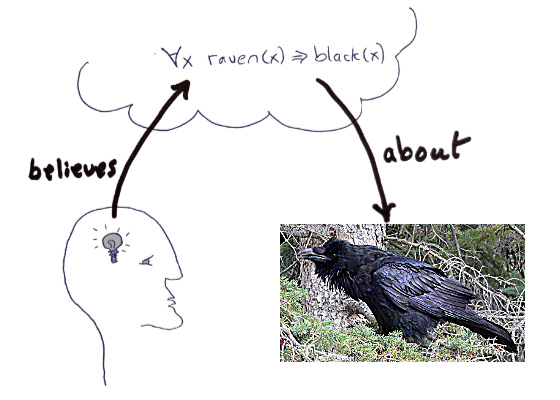
Philosophers use the word “proposition” to designate whatever is the sort of thing one believes or disbelieves, or that could be true or false. They can’t say what sort of thing that is, though, or how one would work.
This is a serious problem for rationalism. If “what kinds of thing are beliefs and truths?” sounds to you like ivory-tower metaphysics, of no practical consequence, I mostly agree. However, rationalist epistemology depends on the conviction that some answer is possible.
What we’ve seen so far suggests otherwise. The sorts of things that could be true or believable in an everyday sense—sentences like “the eggplant is purple”—can’t be true or believable in a rationalist sense, because they have no definite meaning. Natural language is too vague. Formal logic attempted to fix that, but could eliminate only some syntactic ambiguities. Mathematical equations, such as laws of physics, might be adequately true or believable, but don’t seem capable of expressing most facts about the eggplant-sized world.
Propositions would have to somehow overcome nebulosity, while retaining the expressive power of natural language. Most philosophers would admit no one has a clue how that could work.
Further, philosophers mainly agree that propositions would have to be mind-independent non-physical objects that are entangled with the physical world:
- It was true that Pluto’s mass was approximately 1.3 × 1022 kilograms before there was anyone to believe it. Where was that truth?
- Propositions are not physical properties of the objects they refer to. Someone might believe that unicorns can fly, even though there are no unicorns.
- Physical things can’t be true or false. If a museum specimen is mislabeled, the paper label isn’t false; it’s just atoms. What’s false is the label’s claim, which is not a physical property of the label.
- If you and I both believe snow is white, we believe the same proposition. If you are a German speaker, you might think “Schnee ist weiss,” and that would express the same belief as my “snow is white.” Apparently propositions don’t live in our heads, and aren’t properties of individuals.
- Some neurons representing the proposition might be in your head, and it might be that your having neurons in some particular state constitutes believing snow is white. But the believing is not the thing believed. Neural states, like museum labels, can’t be true or false.
The correspondence theory of truth postulates a connection (correspondence) between physical brains and physical states of affairs. The nature of the connection is mysterious, but at least the two ends are grounded in physical reality. Rationalist theories attempt to solve the mystery by introducing a third sort of entity, propositions, that sit between brains and the world. But this replaces one mysterious connection with two, each somehow bridging between a physical thing and a non-physical thing:

What work are the propositions doing? If they have no causal role in reasoning, they’re useless. If they do play a causal role, how can physical and non-physical things interact?1
Propositions are spooks, like banshees or angels. No one has ever captured one on camera, or in a zoo. Mind-independent non-physical entities with causal effects: phantoms, specters, apparitions… Rationalism was practically invented to get rid of them!
Why does this matter? Rationalism supposes that there are definite things that you believe; propositions are just whatever those are. But it appears that nothing could play that role. If we accept that the idea of propositions is incoherent—that there is nothing that could be believed or true in the rationalist sense—then we have to abandon the rationalist models for belief and truth.2
We’ve already seen that truths are generally nebulous: only sort-of true. Parts Two and Four discuss the nebulosity of belief as well: to varying degrees, what we believe is nebulous, and how we believe it is also nebulous. And just as truths are sort-of true in different ways, believing that God Is Love has to be understood quite differently from believing that you are wearing blue socks.
- 1.Naturally, philosophers try to come up with work-arounds for all these issues. The Stanford Encyclopedia of Philosophy “Propositions” article demonstrates how difficult the problems are, and how convoluted the responses; and in the end it boils down to “not the ghost of a rumor of a clue.”
- 2.“One person’s modus ponens is another person’s modus tollens.” In other words, the rationalist conception of belief leads to contradictions, so it must be wrong.